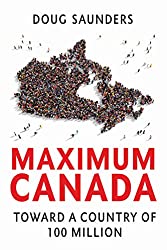
Rating: 8.2/10.
Maximum Canada: Toward a Country of 100 Million by Doug Saunders
Book about the history of immigration in Canada. Today, Canada is recognized as one of the most multicultural countries in the world, but Canada has only been multicultural fairly recently, since the 1960s. In the 19th century, Canada was set up as an extractive colony to create wealth for the mother nation – it was economically closed off so that it would be dependent on Britain for imports and exports, barriers were put to limit trade with America, and the government mostly limited immigrants to an ethnically homogeneous makeup of British settlers. As a result, Canada was poor and people didn’t stay for long: apart from a few brief bursts of immigration (such as Americans fleeing the Revolutionary War or the Irish emigrating during the Great Famine), Canada constantly lost population to America. The losses were especially devastating because immigrants tended to be the more ambitious, better educated, and entrepreneurial types, who found that in order to get opportunities, you had to move to the south.
Free trade with the US improved in the 1840s, when Britain stopped treating Canada as an extractive colony and removed trade restrictions, so the Canadian economy improved. However, for a long time the government still had the view that new immigrants should be farmers, and discouraged skilled immigrants, even though most Canadians were moving into cities for non-agricultural work. As a result, throughout the 19th century, Canada never developed modern economic institutions Comparable to those in the US and remained in relative poverty. Contrary to the government’s hopes and expectations, new immigrants mostly moved to the cities anyways, since agricultural technology had gotten so efficient that there was little need for more farmers. Additionally, Canada developed an antagonism towards the Chinese and other ethnic minorities, first issuing a head tax for Chinese immigrants to discourage them from coming, and eventually banning non-British immigration almost entirely from the period between 1910 until the end of WW2.
After WW2, Canada reluctantly started to welcome immigration once again, faced with international pressure from a large number of refugees and the growing realization that the country was underpopulated. There was so much emigration to the US during the century from 1850 to 1950 that despite the high birth rate, Canada’s population only grew slightly. The immigrants settled and grew in political power, and by the 1960s, Canadians no longer saw themselves as having a white Anglo-British identity. Political attitudes shifted during the 1960s, embracing multiculturalism as a way for new immigrants to integrate into society, as well as increased rights for indigenous people. During this period, there was some tension with Quebec, who wanted to preserve their francophone culture and preferred immigrants from French speaking countries.
The last third of the book discusses contemporary immigration policy, including the advantages and disadvantages of immigration. Higher population has numerous advantages: businesses would have a larger domestic market, which is why it’s easier to start companies in the US than Canada. It is possible for Canadian companies to sell globally, but many countries are increasing trade restrictions, making this more difficult in the future. Small population density is also less energy efficient per capita, for example, it cannot support larger public transport systems. Immigration must also be managed carefully, and there are many ways that it might go wrong. Many first-generation immigrants work in underskilled jobs like Uber drivers, Currently, second generation immigrants are fairly successful at integrating into Canadian society, but this may change as full time jobs become more scarce. Immigrants might end up in permanent ethnic enclaves, and never truly integrate into broader society, as has happened in many countries in Western Europe. Overall, the author has a positive attitude towards immigration, and believes the goal of 100 million Canadians by 2100 is achievable without too much difficulty, and we will end up with our expansion of population in the largest three metropolitan areas.



